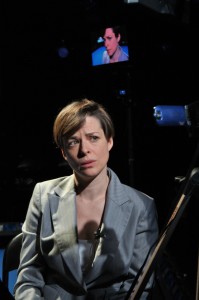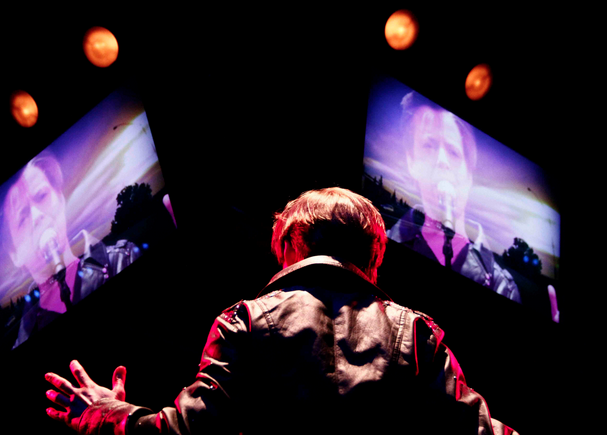The Wholehearted
Kelly Strayhorn Theater sat down with Stein | Holum Projects‘ playwright/director Deborah Stein and performer/director Suli Holum to discuss The Wholehearted, a nuanced piece about a prized female boxer with a haunted past and seeking redemption. Audiences can check out The Wholehearted at KST on March 20–21 & 26–28.
How did the Wholehearted come about?
 Suli Holum :: We were looking for a complicated project that we had to grapple with and immerse ourselves in a world that was unfamiliar to us. I found the story about a boxer named Christy Martin in the New York Times and that led us into researching women’s boxing and persons facing interpersonal violence.
Suli Holum :: We were looking for a complicated project that we had to grapple with and immerse ourselves in a world that was unfamiliar to us. I found the story about a boxer named Christy Martin in the New York Times and that led us into researching women’s boxing and persons facing interpersonal violence.
Deborah Stein :: When we were learning about Christy we asked ourselves, “Why is she still boxing? Hasn’t she learned that violence is not the answer?” We had a gut reaction to her story, and we wanted to make a play about it— we did not recreate her story or make a documentary piece, this is fiction, but we were more interested in our reaction to the material.
How did you settle on the theme of boxing?
SH :: We were really interested in the story of a woman who is physically strong and powerful but could still be overpowered by a different kind of violence, so the play is about different kinds of violence, that men can do, that women can do, socially acceptable violence, sexual violence, and what it means to fight back. To win. To survive.
Boxing is a violence that is condoned. What is the difference between two women beating each other to a pulp in front of a crowd and a woman being beaten to a pulp in her living room by a man? That’s the interesting, murky territory that’s a huge part of the show.
 How would you say this story distinguishes itself from other narratives about domestic violence?
How would you say this story distinguishes itself from other narratives about domestic violence?
SH :: Our protagonist is a little bit scary. We didn’t want to tell a survivor story. We wanted to talk about the lasting effects of trauma. What it means to be living with violence instead of conquering it. In our research we found it was more true that people that face acts of violence and commit acts of violence carry that with them, always.
DS :: We wanted something that divulged from the traditional Hollywood narrative. Our play is deliberately set while our character is trying to make a comeback, and has failed at that comeback and has the rest of her life to live. That’s what we’re interested in. How does she feel about the experience she’s living in?
 What other themes are in this piece?
What other themes are in this piece?
SH :: Celebrity, class, what it means to try to escape a working class situation and be someone. Gender identity and sexual preference — our character struggles with how to be herself and be successful.
How did you decide to incorporate film?
We’ve had an ongoing collaboration with designers and we’ve worked with projections in our last show. We wanted to do some cinematic stuff, and create a presentation to show media’s portrayal of violence.
The idea that I’m playing a bunch of different characters came from our research about trauma. It’s a poem about how we carry people with us. That people who have affected us…we carry them in our bodies. Those people live in our protagonist. Those voices have had such a deep effect on her. We are looking at memory as a living, active, physical thing, not as a reflective state.
DS :: We also see the camera as a character. We think about the relationship between the protagonist and the real camera on stage, the camera in her mind, the movie of her life that she thinks she’s starring in — that’s a big part of it too.

Can you tell us more about the set design?
SH :: It’s set up the way an audience would see a boxing match, an arena. The action of the play happens in a photo-realistic space, a run-down, back-room gym, her hideout. Her husband is getting out of jail. But her imagination takes her back to the center of the ring when she’s a prizefighter. The audience gets to spy on her and see where her memories take her.
Can you tell us more about your previous residency at KST?
DS :: We were working a lot on sound during that residency. We also used that time to test the configuration of the screens on stage, so it was really useful to be able to show up with our stuff and try it out. It was also good to have an audience there and the talkback was really important, to hear from audience members what questions the piece rose for them. We learned that the piece was engaging them and made them need to talk to each other afterward. People were having arguments, respectful debates: “Why would she do that?” They were grappling with what’s acceptable with violence. That was helpful in the evolution of the piece.

SH :: The thing about The Wholehearted is when it ends, you don’t feel okay. It’s important that people know after it’s okay for them to stay and process it a little bit. We are asking hard questions, subconsciously, and creating the space for this discussion to happen.
The Wholehearted will be at the Kelly Strayhorn Theater beginning Friday, March 20th for a five night engagement. Get more info and purchase tickets here.
Photos courtesy of Stein | Holum Projects



Comments are closed